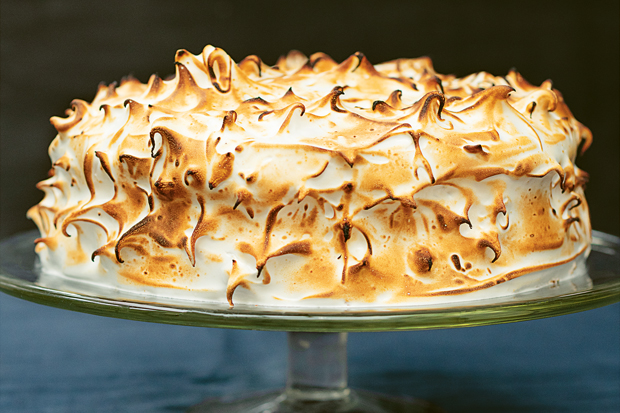Recipe
July 2, 2021
Nigella Lawson’s Toasted Marshmallow & Rhubarb Cake

Try this Toasted Marshmallow & Rhubarb Cake from the new cookbook, Cook, Eat, Repeat.
 This is splendidly celebratory but not dauntingly difficult. You need a bit of elbow grease and a blowtorch; I can’t tell you how much I enjoy teasing out the snowy spikes of marshmallow-meringue and then scorching them.
This is splendidly celebratory but not dauntingly difficult. You need a bit of elbow grease and a blowtorch; I can’t tell you how much I enjoy teasing out the snowy spikes of marshmallow-meringue and then scorching them.
Directions
Yield: Makes 8 to 12 slices
Cook Rhubarb
- Heat oven to 400°F. Cut trimmed rhubarb ribs into 2″ lengths if slender, 1″ if chunky. Put into an ovenproof dish in which they will be able, more or less, to sit in a single layer — I use an 8″ x 10″ Pyrex dish — and sprinkle over 1⁄2 cup (100 g) of granulated sugar.
- Mix together with your hands, leaving the rhubarb in a single layer as much as possible, then cover the dish with foil, sealing edges well, and cook in the oven for approx. 30 minutes, until rhubarb is tender but still holding its shape.
- Remove foil, and leave dish out on the countertop, watching it glow ever more pink as it cools.
Make Batter
- Turn oven down to 325°F. Line bottoms of two 8″ cake pans with parchment paper, and lightly grease the sides.
- Separate the eggs, dropping the whites into a large mixing bowl or bowl of freestanding mixer (whichever bowl you’re using should be thoroughly washed and grease free) and yolks into another. Cover the bowl of whites with food wrap, and put to one side while you mix and bake the cake.
- Finely grate the zest of lemon and add to the bowl of yolks. Measure out milk, juice the lemon and add 2 tbsp of the juice to the milk, and leave to stand for a moment. Mix together cornstarch, flour, baking powder, baking soda and salt, and set this aside for now.
- Add 3⁄4 cup (150 g) of superfine sugar and oil to the yolks and whisk on medium-high speed for 3 minutes, by which time the mixture will be rich, gleaming and billowy.
- Still whisking, but more slowly now, gently pour and scrape in now curdled milk and, once it’s in, carry on whisking until it’s combined; the mixture looks like custard at this stage. Finally, whisking more gently now, gradually spoon in dry ingredients. Once in, use a spatula to scrape down the sides and fold everything gently together, before dividing the mixture between prepared pans.
Bake Cake
- Bake for 20 to 25 minutes, by which time the cakes will have risen up extravagantly, the tops golden brown; they will feel soft and puffy to the touch, but the cake tester should come out clean.
- Remove to a wire rack and let the cakes cool in their tins for 15 minutes — sinking a little as they do so — before very carefully turning out. You’ll need to loosen the edges with a small offset spatula first. These are tender sponges, so don’t rush or be rough. Once unmolded, gently pull back and remove the lining papers straightaway.
Frost & Assemble Cake
- When the cakes are completely cold — which will take about an hour — you can get on with frosting. But first, tear off four strips of parchment paper, scrunch them, then unscrunch them and lay them flat to make an outline of a square on top of the cake stand. (This is to stop you covering the cake stand with sticky marshmallow frosting later.)
- Put one cake on it, top-side down, the paper strips under the edges. Also, now’s the time to lift the rhubarb pieces out of their syrup in the dish and onto the plate.
- In a tall saucepan that you can sit your big bowl o’ whites on (without the bottom of the bowl touching the water), heat a little water in it until it’s just about to come to simmer. Mix 1 3⁄4 cups (350 g) of superfine sugar, salt and cream of tartar (or lemon juice) together and add it to the egg whites. Then sit the mixing bowl on top of the pan, so it’s gently warmed by the barely simmering water underneath and, just using a balloon whisk (thoroughly washed and grease free, again), keep whisking for 3 minutes to the dissolve sugar. I couldn’t say this is hard to do, but you can really feel it in your forearm. I’m always grateful when my timer goes off.
- Once the sugar’s dissolved and you have a smooth, opaque mixture that’s warm to the touch, remove the bowl from the saucepan. Whisk at high speed for 5 minutes in a freestanding mixer, or for 6 to 7 minutes if using an electric hand mixer, by which time the whites will be very thick and ludicrously voluminous.
- Whisk in 1 tsp of vanilla extract and, when it’s incorporated, whisk in the remaining tsp, then give it a good fold by hand to make sure every bit is mixed in.
- Dollop a generous amount of marshmallow frosting onto the waiting cake, and smooth it right to the edges, so that you have a layer about 1⁄2″ thick: this should use about a quarter of the frosting.
- Cover this with rhubarb, though leave about a 1⁄4″ perimeter around the edge; I go slowly here, using a couple of soup spoons to ferry the rhubarb to the cake. And you might want to tilt the rhubarb plate away from you slightly as you transfer slices, to make sure you leave any pooling liquid behind.
- Top with the second cake, right-way up, and use just under half the frosting left in the bowl to cover the top, going just beyond edges. Then carefully spread the rest of the frosting thickly around the sides — leaving a tiny bit in the mixing bowl — until the whole cake is completely covered.
- Dip your fingers in the bit of frosting left and dab the top and sides of the cake, lightly pulling up and teasing out spikes of marshmallow frosting; I feel like an ’80s hairdresser doing this. Sometimes, as you do the sides, you will pull bits of frosting off, but don’t panic, just pat it back on.
- Gently pull out the strips of paper from beneath the cake, then seal the bottom of the cake with any remaining frosting. Then, slightly dampen a paper towel with cold water, and rub off any stray bits of frosting or sugar smear from the plate.
- Take the cake somewhere you can kindle fire safely. Light a blowtorch and, holding it fairly near the cake and with not too timorous a flame, toast the top and sides of the frosting. I find this cake easiest to slice if left to stand for a couple of hours before serving. And you need to slice generously, as with all layer cake.
Source:
Recipes from Cook, Eat, Repeat: Ingredients, Recipes, and Stories by Nigella Lawson. ©2021 by Nigella Lawson. Photography ©2020 by Jonathan Lovekin. Published in Canada by HarperCollins Publishers. All rights reserved.


